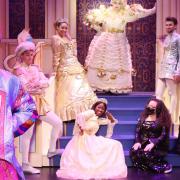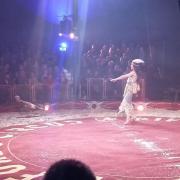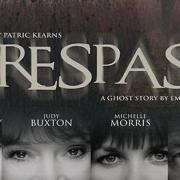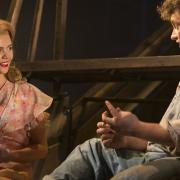This is one play where ‘boos’ are part of the story; for this is a ghostly experience guaranteed to have you jumping out of your seat. But choose your audience carefully, says Katie Jarvis
This is scary. I don’t mean The Woman in Black (though, blimey, that’s scary, too); I mean writing this review. The Guardian (I googled it) (plus the rest of the world, I guess) loved this stage adaptation by Stephen Mallatratt; the 16-year-old girls, who packed the Everyman audience, adored it, judging by their screams and giggles. And I… well, let’s talk a bit more about the basics, first.
What makes The Woman in Black such a cracking novel – like all good ghost stories – is its minimalism. The way the suspense is racked up by small details that blend ectoplasmically together. Not by bloodied knives or blunt axes or rattling chains; rather, the obscuring mists, rolling off the sea; the appearance of an unexplained woman in mourning; a locked room; the sound of an empty rocking chair. An isolated, rambling house of grey stone. Two o’clock in the morning. Bleakness. Loneliness.
This is the gothic mini-masterpiece, written by Susan Hill in the early 80s – a novelist long associated with the Cotswolds (or, at least, the Oxfordshire bit). It was hard to see how the popularity of the written word – with its vast empty spaces; its pony-and-trap; its treacherous marshes; its (relatively) long list of characters; its faithful dog – could be transferred to the confinement of a stage. But then along came Stephen Mallatratt, a rather extraordinary playwright, who specialised in confounding expectations. Beginning his career in the building trade, he went on to write for (and, unusually, also to appear in, in the case of the former) Coronation Street and The Forsyte Saga. But his skill as a dramatist came to the fore when he was asked by director Robin Herford to find a ghost story for a low-budget production at the Stephen Joseph Theatre in Scarborough. Stephen came up with a (extremely inventive) take that involved a cast of just two, and a list of props that mainly revolves around a coat rack, a travelling trunk, two chairs, and an enormous amount of imagination from the audience. But somehow – somehow – it worked. And it made Mallatratt’s name. (Tragically, he died from leukaemia at the age of 57.)
So, to the Everyman… the action on stage opens comedically, with a dull Arthur Kipps (Malcolm James) being coached by an actor (Matt Connor) in the telling of his dreadful ghost story. But, to begin with, the really dreadful thing about the ghost story is Kipps’s delivery; the coach has work to do. But it’s in that telling that the action unfolds on the same bare set throughout, where a travelling trunk doubles up as the trap pulled by an imaginary pony; where a change of coat is a change of character; and where the sound system is the clopping of horses, the rush of waves, and the cry of a lone bird in an empty sky. And then there’s the mist that swirls around the stage, before wrapping itself round an audience that, by the middle of act one, is as nervous and jumpy (I won’t give too much away) as any I’ve ever been a part of. Seriously, if you don’t startle at least once, you should get your reflexes checked by your GP.
The first thing to say about the Everyman production is how utterly brilliant these two almost-entire-cast members are: whether intentionally boring; or enthusiastically funny; or in fear of their sanity.
But, for me, this is a production that – and if that’s what you want, then great – relies more on jumpstarts than a racking up of tension. This was a ghost train, rather than Murder on the Orient Express. For a start, I didn’t really understand why Kipps would want to employ a voice coach to tell a story that haunts him for life. But the 16-year-olds, with which the audience was packed (this is a GCSE text), loved it: I loved rather less their loud ‘OMG’ discussions after every bump in the night. And perhaps that was part of the problem. Maybe if I’d seen it with a different set of observers, I’d have got it. But for that reason, the terrible end – when it came – seemed not a revelation of ghastly evil; more an after-shock that didn’t deliver.
But maybe I was a minority of around one. This production is most certainly an experience. A fun experience. A spectral experience. My advice, I have to say, is to check the average age of the audience before you go.
• The Woman in Black is at Cheltenham Everyman until Saturday, November 8; 7-10 Regent St, Cheltenham GL50 1HQ, 01242 572573; www.everymantheatre.org.uk



























